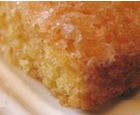|
Italian Side Cheese Polenta The variations for polenta are too many to list. It can top a meat casserole or sit underneath a fish stew. Use a packaged mix for this recipe if you like.
Polenta: in a large saucepan, bring water and salt to a boil and add cornmeal in a slow stream (make sure the water continues to boil). Continue pouring and stirring for about 30 minutes. When done, the cornmeal will be thick and pull away from the sides of the pot, the consistency of firm mashed potatoes. Assembly: preheat the oven to 350. Spread 1/2 of the mixture into a 9" x 12" buttered casserole. Layer the sliced cheese on top,* then spread the remaining 1/2 of the polenta and top with grated Parmesan. Bake for 35 minutes till top is golden brown. Let rest for 5-10 minutes before slicing into 3" squares.* * Try this variation—Polenta Alla Lodigiana: add prosciutto to the layer of cheese. Cut into squares but, instead of baking, dip squares into egg, flour, and breadcrumbs. Fry the squares in melted butter to make fritters. |
Tips & Glossary Arborio Rice: a medium-grained rice. Its high starch content yields a creamy texture and is the basis for risotto. Balsamic Vinegar: dark, thick vinegar with a sweet pungent flavor. Fermented, concentrated, and aged in wooden casks, sometimes up to 12 years. Can be pricey. Caper: salty, pickled bud of spiny shrub native to the Mediterranean region. Most prized is the non-pareil, the smallest (approx. 1/8”), though other sizes are tasty and less expensive. Formaggio: Cheese! Like France, Italy is a land of sublime cheeses, some 400 varieties. Here are some of the most widely sold in the U.S. Italian Seasoning: blend of dried herbs used in Italian cooking—marjoram, thyme, rosemary, savory, sage, oregano, and basil. Packaged commercially and found in most food stores. You can also make your own. Olive Oil: There's much more to know than is room for here. To learn all you need to know about the different grades of oil, and much, much more, head to Tanbourit. Pine Nuts: pinoli or pignoli; edible seeds of pine trees used in pesto sauce. Before cooking, release flavor by lightly browning in a heated skillet. Roasted peppers: buy or make your own: place under a broiler, or hold over a gas flame, till skin chars and blisters. Place in a closed paper bag for 15-20 minutes (to steam them). When cool, the skins slip off under water. Prosciutto: especially Prosciutto di Parma, dry-cured ham from Parma. The real deal! Cured up to 2 years, is almost sweet and very expensive. You can substitute with capicola, a delicious, light peppery ham.
|

